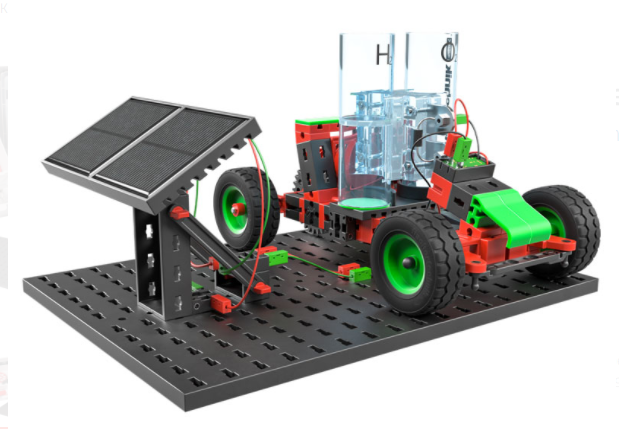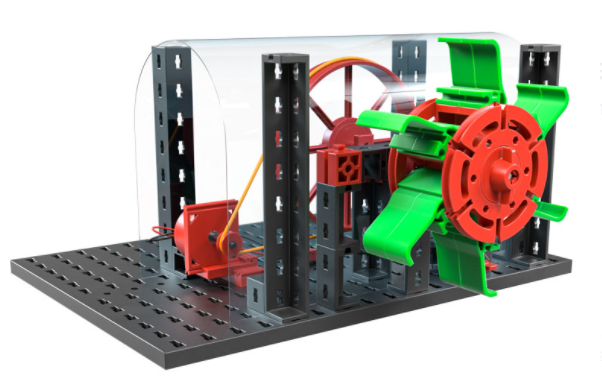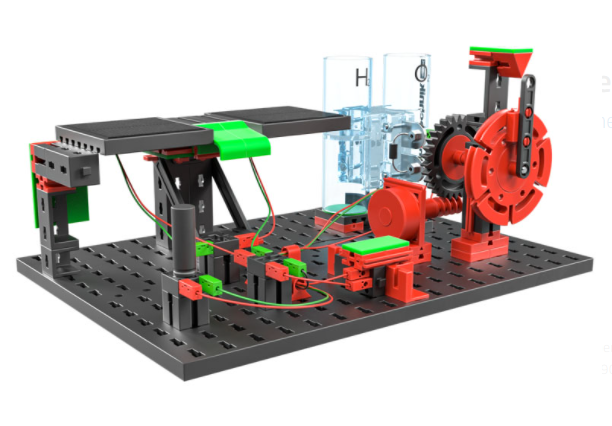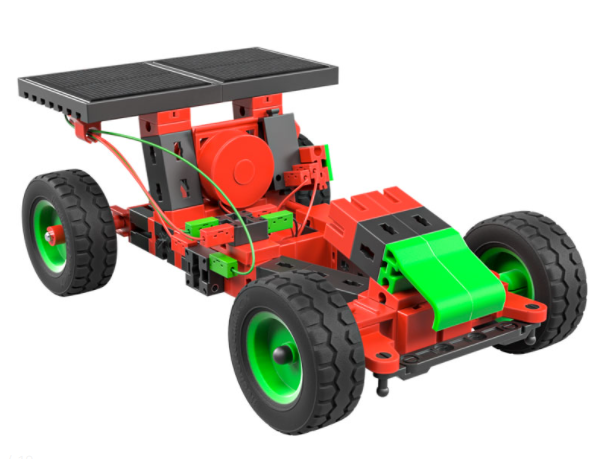STEM אנרגיות מתחדשות - מימן תא דלק, שמש סולארי, הידרו, רוח
קרא עוד
STEM אנרגיות מתחדשות - מסמך מוצר
הפוך את היסודות של אנרגיות מתחדשות למובן ולהבטיח הבנה מתמשכת!
מקט ITE559881 Fischertechnik
לחומרי ההוראה ולתוכניות השיעור
עובדות מובילות:
1. 268 רכיבים כלולים
2. 9 מודלים הניתנים לבנייה מהירה ו-28 ניסויים מרגשים לבתי ספר תיכוניים
3. הזמן הנדרש עבור גיליונות המשימות הוא 45 עד 90 דקות
4. הוראות הרכבה מודפסות מצורפות ,צבעוניות ומקצועיות
5. מתאים לעבודה קבוצתית של 2 עד 4 תלמידים
תיאור המוצר
כיצד נוצר כוח ידידותי לסביבה?
כיצד פועל תא דלק, וכיצד ניתן להשתמש בו כדי לייצר מימן?
מקורות אנרגיה מתחדשת יהפכו למקורות האנרגיה החשובים ביותר בעתיד.
תשעה דגמים ו -28 ניסויים משמשים להדגמת הייצור, האחסון והשימוש בחשמל ממקורות טבעיים כמו מים, רוח ואנרגיה סולארית.
מודלים סולאריים רבי עוצמה יכולים להיות מחוברים בדרכים שונות לשימוש רב-תכליתי בדגמים. כובע הזהב הכלול משמש כמערכת אגירת אנרגיה, ויכול להפיק אנרגיה מאוחסנת.
תא הדלק מדגים בבירור כיצד מים מפוצלים לשני הרכיבים מימן וחמצן. זה מלמד את הילדים על מקורות אנרגיה עתידיים ועוזר להם ללמוד מיומנויות חשובות.
קישור לקובץ החלקים - מומלץ להוריד ולהדפיס
קישור לקובץ הוראות הרכבה - מגיע מודפס בערכה מומלץ להפנות את הילדים לעמוד ספציפי בכל דגם
 |  |  |
 |  |  |
 |  |  |
סט שלם של מערכי שיעור מסייע למורים להשתמש באנרגיות מתחדשות STEM שנקבעו בכיתה.
חומר הוראה נלווה:
מוצרי החינוך של פישרטכניק כוללים חומרי הוראה מקיפים ונגישים באופן חופשי. אלה פותחו יחד עם מכללות להכשרת מורים, מתאימים באופן אידיאלי לצרכים של הכיתה. בנוסף להקדמה לנושא, זמינים מערכי שיעור עם גיליונות משימות והפניות לתוכנית חינוכית.
- מבוא לנושא מספק תוכן שניתן להשתמש בו בצורה אופטימלית להכנת שיעורים ולשלב אותו בשיעורים. הגדרות, היסטוריה, ידע בסיסי ועוד הרבה יותר מסופקים.
- חומר ההוראה כולל סקירה של יעדי הלמידה וכן את הזמן הנדרש למשימות.
- בהתאם לנושאים הרלוונטיים לתוכנית הלימודים, נכללות משימות שונות בהן מטופלים ניסויים שונים.
- המשימות מחולקות למשימת בנייה, משימה נושאית ומשימת ניסויים. בדרך זו, אחד מתקדם מבנייה, ללמוד תוכן טכני, ליישום הידע הנרכש.
לחומר ההוראה
ייצור, אחסון ושימוש בזרם חשמלי / מקורות אנרגיה: מים, רוח, שמש ומימן
STEM Renewable Energies
Make the basics of renewable energies understandable and ensure lasting comprehension!
Art.-No. 559881
To the teaching materials and lesson plans
Top Facts:
• 268 components are included
• 9 quickly buildable models and 28 exciting experiments for secondary schools
• The time required for the task sheets is 45 to 90 minutes
• Enclosed printed assembly instructions
• Suitable for group work of 2 to 4 pupils
Product Description
How is environmentally-friendly power generated? How does a fuel cell work, and how can you use it to produce hydrogen? Renewable energy sources will become the most important sources of energy in the future. Nine models and 28 experiments are used to demonstrate the production, storage and use of electricity from natural sources like water, wind and solar power. Powerful solar models can be attached in different ways for versatile use in the models. The included Gold Cap serves as an energy storage system, and can output stored energy. The fuel cell clearly demonstrates how water is split into the two components hydrogen and oxygen. This teaches children about future energy sources and helps them learn important skills. A full set of lesson plans helps teachers use the STEM Renewable Energies set in the classroom.
Accompanying teaching material:
fischertechnik Education products include comprehensive, freely accessible teaching materials. These have been developed together with teacher training colleges, teachers and didacticians and are ideally suited to the needs of the classroom. In addition to the topic introduction, lesson plans with task sheets and educational plan references are available.
- The topic introduction provides content that can be optimally used for lesson preparation and integrated into the lessons. Definitions, history, basic knowledge and much more are provided.
- The teaching material includes an overview of the learning objectives as well as the time required for the tasks.
- In line with the curriculum-relevant topics, various tasks are included within which different experiments are dealt with.
- The tasks are divided into a construction task, thematic task and experimentation task. In this way, one progresses from building, to learning technical content, to applying the acquired knowledge.
To the teaching material
Highlights:
• Generating, storing and using electrical current / energy sources: Water, wind, sun and hydrogen
